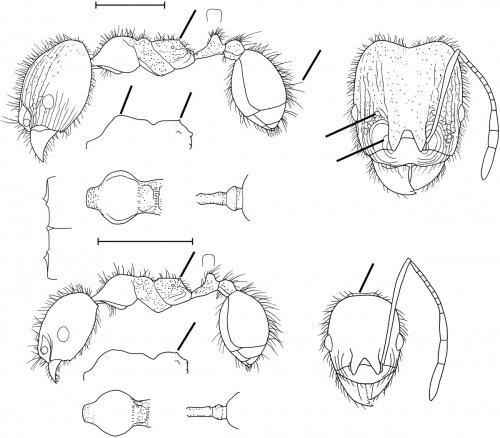Pheidole hamtoni
| Pheidole hamtoni | |
|---|---|
| Scientific classification | |
| Kingdom: | Animalia |
| Phylum: | Arthropoda |
| Class: | Insecta |
| Order: | Hymenoptera |
| Family: | Formicidae |
| Subfamily: | Myrmicinae |
| Tribe: | Attini |
| Genus: | Pheidole |
| Species: | P. hamtoni |
| Binomial name | |
| Pheidole hamtoni Wilson, 2003 | |
Nothing is known about the biology of hamtoni.
Identification
See the description in the nomenclature section.
Keys including this Species
Distribution
Known from the type locality and from 8 km northwest of Tequila, Jalisco, 1220 m, col. R. J. Hamton. (Wilson 2003)
Latitudinal Distribution Pattern
Latitudinal Range: 28.294925° to 20.933354°.
| North Temperate |
North Subtropical |
Tropical | South Subtropical |
South Temperate |
- Source: AntMaps
Distribution based on Regional Taxon Lists
Neotropical Region: Mexico (type locality).
Distribution based on AntMaps
Distribution based on AntWeb specimens
Check data from AntWeb
Countries Occupied
| Number of countries occupied by this species based on AntWiki Regional Taxon Lists. In general, fewer countries occupied indicates a narrower range, while more countries indicates a more widespread species. |

|
Estimated Abundance
| Relative abundance based on number of AntMaps records per species (this species within the purple bar). Fewer records (to the left) indicates a less abundant/encountered species while more records (to the right) indicates more abundant/encountered species. |

|
Biology
Castes
Nomenclature
The following information is derived from Barry Bolton's Online Catalogue of the Ants of the World.
- hamtoni. Pheidole hamtoni Wilson, 2003: 296, figs. (s.w.) MEXICO.
Unless otherwise noted the text for the remainder of this section is reported from the publication that includes the original description.
Description
A member of the fallax group, close to Pheidole azteca but differing from it and other species of the group by the following combination of traits.
Both major and minor brownish yellow.
Major: head capsule 1.14X longer than broad; hypostomum with 5 teeth; propodeal spine greatly reduced, to a rudimentary denticle; postpetiolar node from above short and bell-shaped; pilosity erect and very dense; rugoreticulum present between each eye and the nearby antennal fossa; carinulae mesad to the eye extend almost all the way to the occipital border.
Minor: propodeal spines reduced to denticles; occiput narrowed slightly, with a nuchal collar.
MEASUREMENTS (mm) Holotype major: HW 1.32, HL 1.50, SL 1.22, EL 0.22, PW 0.74. Paratype minor: HW 0.64, HL 0.78, SL 1.02, EL 0.16, PW 0.44.
COLOR Major: body concolorous brownish yellow, except for gaster, which is a shade darker.
Minor: concolorous brownish yellow.
Figure. Upper: holotype, major. Lower: paratype, minor. Scale bars = 1 mm.
Type Material
MEXICO: 10 km northwest of Ixtlán, Nayarit, col. Robert J. Hamton. Museum of Comparative Zoology
Etymology
Named after the collector, Robert J. Hamton.
References
- Wilson, E. O. 2003. Pheidole in the New World: A dominant, hyperdiverse ant genus. Harvard University Press, Cambridge, MA. (page 296, fig. major, minor described)
References based on Global Ant Biodiversity Informatics
- Vásquez-Bolaños M. 2011. Lista de especies de hormigas (Hymenoptera: Formicidae) para México. Dugesiana 18: 95-133
- Wilson, E.O. 2003. Pheidole in the New World: A Dominant, Hyperdiverse Genus. Harvard University Press
